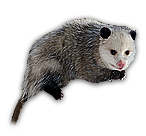General Characteristics:
- A marsupial with the female supporting an abdominal pouch similar to its relative the Kangaroo
- Adults have light gray to black fur, black eyes, a pointed pink nose, pink feet and tail, black ears and a hairless tail
- Adults can grow to approximately 12 inches in height and 32 inches in length
- Weight range is 2-12 lbs.
- Opossums are omnivorous, eating almost any food source available: fish, mammals, birds, insects, crustaceans, grass, fruits, eggs, etc...
- Opossums have a very distinguishable musk-like odour which can be overwhelming
- Solitary and nocturnal creatures
Reproduction:
- They can produce 1-2 litters per year with approx 5-14 young
- Gestation period is as little as 13 days
- Young only partially developed at birth require mothers nursing in pouch for approximately 3 months after birth
- Nests in readily available structures or burrows (does not dig own)
Signs of Infestation:
- May cause damage to lawn grasses while digging for grubs
- May create nuisance trying to nest in structure
- May get into garbage, bird feeders or composters
- In rural areas they may cause damage to poultry or game birds
Control Techniques:
- Live trapping and humane removal to a release site a safe distance from original location is effective
- To discourage these mammals from reoccurrence, all attractants such as food, water, burrows and/or structural holes should be removed and/or sealed off
Please click here to contact a Focus Pest Control professional to inquire about further treatments for this pest species.
References:
Benett, Gary W., et.al.. Truman’s Scientific Guide to Pest Control Operations. Duluth: Advanstar
Communications, 1988. Pp. 354-357.
“Ministry of Natural Resources Fact Sheet: The Virginia Opossum (Didelphis virginiana) In Southern
Ontario. 2008” (On-line). Government of Ontario (MNR). Accessed May 15, 2009 at
http://www.mnr.gov.on.ca/251424.pdf.
Disclaimer:
The Focus Pest Control ‘Pest Library’ is an educational resource written largely to educate the general public about common pests in Ontario. The Focus ‘Pest Library’ does not include all species in Ontario, nor does it include the most recent scientific data about species we describe. Though we edit our accounts for accuracy, we cannot guarantee all information in those accounts. While Focus Pest Control staff and contributors provide references to books and websites that we believe are reputable, we cannot necessarily endorse the contents of references beyond our control.
(Back to top)
|


